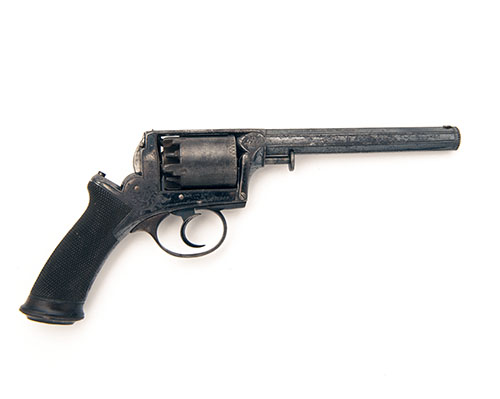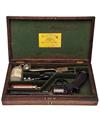Product Details
DEANE ADAMS & DEANE, LONDON
A FINE HISTORIC CASED 54-BORE PERCUSSION REVOLVER, MODEL 'ADAMS PATENT', serial no. 12962R,
circa 1854, with blued borderline engraved octagonal barrel, engraved band at muzzle, scroll engraving at breech, the top-strap and flat signed 'DEANE ADAMS & DEANE, 30 KING WILLIAM ST.T, LONDON BRIDGE', the right hand upper flat engraved 'H.B. ROBERTS R.M.A', dove-tailed fore-sight (blade absent), standing notch rear-sight, plain five shot cylinder with engraved band to front edge (traces of colour), blued borderline and scroll engraved solid frame, self-cocking action with spurless hammer, chequered walnut semi saw-handled grip with iron pommel-cap and central cap-box, guarded trigger and no provision for rammer, much original blued finish remaining, together with its makers trade labelled oak storage case compartmented and lined in green baize (losses to some compartments), and including an 'ADAMS' trademarked mould, a nipple-key, oil bottle, loading rod with tool end, wad punch, Dixon flask and kid leather ammunition pouch
Provenance: Henry B. Roberts was a Captain in the Royal Marine Artillery. The following was taken from an article on the Roberts medals by Brian Best and originally published in Medals International in 1981:
"On October 11th Roberts was sent to rejoin his regiment at Balaclava. He commanded No. 4 battery on Marine Heights which protected the right flank of the British position. In a letter to his mother written on the 27th October, Henry describes the events leading up to and including the day of the 25th, a day prominent in British military fokelore for blunders and heroism, its lost opportunity and steadfastness.
On the evening of the 23rd Sir Colin Campbell (his commander) sent for him and asked "Be a good boy, go up the hill and superintend the formation of three guns for the sake of an old fellow who has a great deal of responsibility on his shoulders". With the help of the Highlanders and Turks the job was completed by the evening of the next day. Fatigued by the days labour, Roberts slept soundly only to be awakened in the early morning by the sound of gunfire and the clamour of the 93rd Highlanders getting under arms. Taking his position on Marine Heights behind the 93rd, Roberts saw the start of the battle of Balaclava.
Across the valley the Russians advanced and overwhelmed the Turkish-held redoubts on Causeway Heights, whilst the great grey mass of Russian cavalry surged the South valley. The greater part of the mass halted and received the charge of the Heavy Brigade under General Scarlet. Four squadrons were detached by the Russian Commander, Ryjov, to destroy the artillery park at Kadokol. The Turks having fled, all that stood between them and their objective was Sir Colin Campbell's small force of Highlanders and Artillery. Roberts was now actively engaged in the battle.
"Upon this mass of cavalry we brought 5 guns to bear and poured 24 pound, 32 pound and 8in. shells amongst them, myself rushing about from one gun to the other seeing the fuzes bored and laying the guns - and our practice was most admirable, the shells bursting amongst them and where they fell horses were seen to reel and fall with their riders. The gallant 93rd received a charge in line and poured rifle balls amongst them, file firing they stood like a wall. On their retreat my guns took most..."
Later in his letter he writes "...our practice was the admiration of the 93rd, who were in a position to see its full effects and they say it had a great influence on the day. Several of them say it is a great injustice if I am not mentioned in despatches." He wrote to his sister a week later about the General Order of Congratulations, which again omitted the Artillery. However, he put on a brave face which only the Victorians could manage and wrote "...however I feel that the consciousness of our having done so well is quite sufficient reward as far as I am concerned".
For several days after the battle his sector were constantly on the alert for another attack and several artillery duels took place. One night the Cossacks got close enough to pepper the Marine's tents, much to Roberts consternation. Later, carefully watching the Cossacks outposts, he ventured out into the South valley, to where the Heavy Brigade fought "...mountains of horses lay dead and interspersed amongst the Russian dead whom we have since buried". He also describes the results of the firing, the stench of death and the omnipresent vultures. He describes the onset of the horrendous winter which all but finished the British as an effective force "...everything wears a thick coating of frost and the plumes of the Highland bonnets shew white instead of black".
When the Navy were sent to reinforce Marine Heights, Roberts was happy to transfer to the Royal Engineers as Assistant Engineer under General Jones. He received complimentary letters for his work from Jones and from his old Commander, Colin Campbell, who obviously took a shine to the young man. From the spring of 1855, Henry was in the trenches before Sebastopol with the Artillery Siege Train. Unhappily his health broke and he was invalided home in July. He remained in the Marines for a further 25 years, retiring with the rank of Colonel in September 1873. His painting hangs in the Royal Marines Museum.
Please click HERE to view Terms & Conditions.
Estimate £2,500-3,500 € 2,774-3,884





